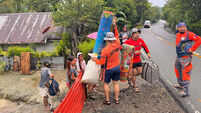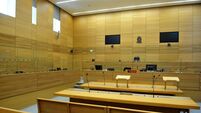Jeanne kills three on rampage through Florida
It was the fourth hurricane to hit the Sunshine State in the past six weeks, something that has not happened since 1886, when Texas was the target.
Winds of 120mph and drenching rain tore off rooftops, hurled debris through the air and sent huge waves crashing into buildings.
The Federal Emergency Management Agency has responded with the largest deployment in its history, eclipsing response for the 1994 earthquake in Northridge, California, and the 2001 terrorist attacks, FEMA Director Michael Brown said.
“You’re going to have some areas that have been hit once, twice and sometimes three times, and just as you think you’re making headway, you’ve got to go back in,” Mr Brown said.
The category 3 storm made landfall shortly before midnight local time near the southern tip of Hutchinson Island, the same area ravaged by Hurricane Frances three weeks ago.
One person was electrocuted in Miami after touching a downed power line.
Debris left from the other hurricanes - Charley, Frances and Ivan - flew through the air as Jeanne came ashore.
Sections of road were washed out by pounding waves as the 400-mile diameter storm swirled into central Florida, an area saturated by rain from two previous hurricanes.
At the Ocean Breeze trailer park in Jensen Beach, roofs of mobile homes were peeled back like the lids of sardine cans. Computer printers, hair dryers and propane canisters littered the road.
Emergency management officials were assessing the damage. The previous hurricanes caused billions of dollars in damage and killed at least 70 people.
At one of the causeway bridges leading to Hutchinson Island, a boat bashed against the seawall and sank. Within minutes, all that remained above water was less than 1ft of its yellow mast.
Jeanne made a turn to the north over central Florida and was expected to stay inland over Georgia and the Carolinas until tomorrow.
By early yesterday, it had weakened to a category 2 storm with 110mph sustained winds, but it covered most of the central Florida Peninsula, including Tampa and Orlando.
Max Mayfield, director of the National Hurricane Centre in Miami, said the similar paths of Jeanne and Frances were remarkable. Mayfield said it was the “first time ever that we know of” that two hurricanes landed so close in place and time.
Rainfall totals of five to 10 inches were expected in the storm’s path, and flooding could be a major concern because previous hurricanes had saturated the ground and filled canals, rivers and lakes.
At least 1.5 million homes and businesses were without power, including much of Palm Beach County. Even before Jeanne hit, some 80,000 people had no electricity in the panhandle following Ivan.
Two million people had been urged to evacuate. State officials said more than 42,500, many with homes already damaged by Frances, stayed at shelters.
Earlier, Jeanne tore across the Bahamas. No deaths or serious injuries were reported there, but the storm was earlier blamed for more than 1,500 deaths in floods in Haiti.
Jeanne followed hurricanes Charley, which struck on August 13 and devastated southwest Florida, Frances, which struck during the Labour Day weekend, and Ivan, which blasted the western Panhandle when it made landfall in nearby Alabama on September 16.













